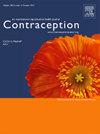妊娠≤9周药物流产中与剧烈疼痛相关的因素:一项多中心、随机、安慰剂对照试验的二次分析
IF 2.3
2区 医学
Q1 OBSTETRICS & GYNECOLOGY
引用次数: 0
摘要
目的:探讨妊娠≤9周药物流产中疼痛管理方案以外与剧烈疼痛相关的协变量。研究设计:这是对越南、尼泊尔和南非的一项随机试验的二次分析,该试验调查了药物流产期间的两种预防性疼痛管理方案。我们使用多变量逻辑回归模型来确定服用米索前列醇后8小时内剧烈疼痛的相关因素。结果:在2016年6月至2017年10月期间,556名参与者中有273名(49.1%)经历了严重的疼痛(10分中的bb80分)。在多变量分析中,控制研究中心和预防性治疗组,多胎(OR 0.35, 95% CI 0.23-0.53)与严重疼痛的发生率降低相关,而痛经(OR 1.16, 95% CI 1.07-1.26)和更长的妊娠期(OR 1.05, 95% CI 1.01-1.09)与疼痛发生率增加相关。较高的预期疼痛评分(OR 1.10, 95% CI 0.99-1.23)与严重疼痛轻微相关。在多次分娩的患者中,剖宫产史(OR 3.49, 95% CI 1.24-9.77)、分娩剧烈疼痛(OR 2.36, 95% CI 1.03-5.42)和痛经(OR 1.22, 95% CI 1.08-1.39)与剧烈疼痛显著相关。较长的妊娠期(OR 1.05, 95% CI 0.99-1.11)倾向于与严重疼痛相关。包括年龄、婚姻状况、经济稳定、焦虑或抑郁在内的社会人口学变量与疼痛无关。结论:除了已知的胎次、痛经和妊娠期等危险因素外,本分析表明,药物流产期间的剧烈疼痛与剖宫产史和分娩时的剧烈疼痛显著相关。抑郁和焦虑与剧烈疼痛无关。这些发现可以为寻求药物流产的患者提供咨询。临床试验注册号:ACTRN126130 0 0 017729。本文章由计算机程序翻译,如有差异,请以英文原文为准。
Factors associated with severe pain during medication abortion at ≤9 weeks’ gestation: A secondary analysis of a multicenter, randomized, placebo-controlled trial
Objectives
This study aimed to identify covariates other than pain management regimen associated with severe pain during medication abortion at ≤9 weeks’ gestation.
Study design
This is a secondary analysis of a randomized trial in Vietnam, Nepal, and South Africa investigating two prophylactic pain management regimens during medication abortion. We used multivariable logistic regression models to identify factors associated with severe pain within 8 hours after taking misoprostol.
Results
During June 2016 to October 2017, 273 of 556 (49.1%) participants experienced severe pain (score ≥8 out of 10). In multivariable analyses, controlling for study center and prophylactic treatment arm, multiparity (odds ratio [OR] 0.35, 95% CI 0.23–0.53) was associated with reduced odds of severe pain, while dysmenorrhea (OR 1.16, 95% CI 1.07–1.26) and higher gestational duration (OR 1.05, 95% CI 1.01–1.09) were associated with increased odds of pain. Higher anticipated pain score (OR 1.10, 95% CI 0.99–1.23) was marginally associated with severe pain. Among multiparous patients, history of cesarean delivery (OR 3.49, 95% CI 1.24–9.77), severe pain in childbirth (OR 2.36, 95% CI 1.03–5.42), and dysmenorrhea (OR 1.22, 95% CI 1.08–1.39) were significantly associated with severe pain. Higher gestational duration (OR 1.05, 95% CI 0.99–1.11) trended toward an association with severe pain. Sociodemographic variables, including younger age, marital status, financial stability, and anxiety or depression, were not associated with pain.
Conclusions
Beyond known risk factors of nulliparity, dysmenorrhea, and gestational duration, this analysis demonstrates that severe pain during medication abortion is significantly associated with history of cesarean delivery and severe pain in childbirth. Depression and anxiety were not associated with severe pain. These findings can inform counseling for patients seeking medication abortion.
Implications
Education and counseling prior to medication abortion should include information about the range of factors associated with increased pain. This information can help individuals make informed decisions about their abortion method and, for those choosing medication abortion, better prepare for and optimize their pain management.
Clinical Trial Registration Number
ACTRN126130 0 0 017729
求助全文
通过发布文献求助,成功后即可免费获取论文全文。
去求助
来源期刊

Contraception
医学-妇产科学
CiteScore
4.70
自引率
17.20%
发文量
211
审稿时长
69 days
期刊介绍:
Contraception has an open access mirror journal Contraception: X, sharing the same aims and scope, editorial team, submission system and rigorous peer review.
The journal Contraception wishes to advance reproductive health through the rapid publication of the best and most interesting new scholarship regarding contraception and related fields such as abortion. The journal welcomes manuscripts from investigators working in the laboratory, clinical and social sciences, as well as public health and health professions education.
 求助内容:
求助内容: 应助结果提醒方式:
应助结果提醒方式:


